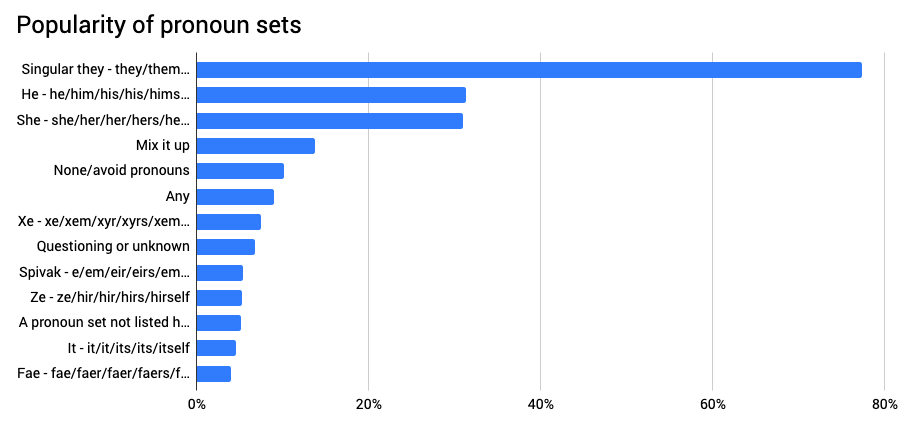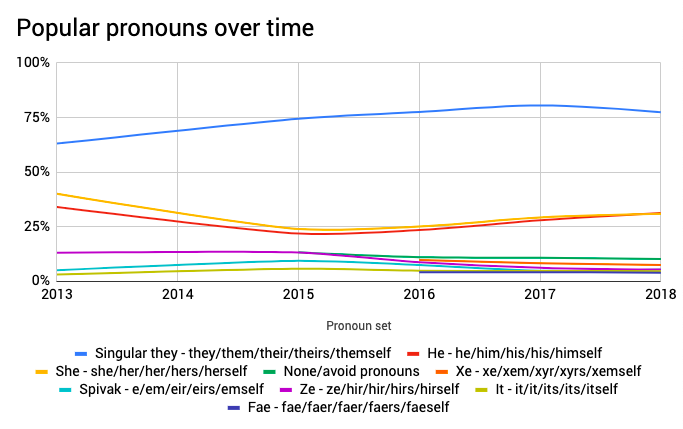The survey took place between 1st February and 25th March 2018, and there were 11,241 respondents, of which 1,528 said they were living in the UK.
The fourth question was a complex set of questions, which started with Supposing all pronouns were accepted by everyone without question and were easy to learn, which pronouns are you happy for people to use for you? This was accompanied by a list of pre-written checkbox options. It included “a pronoun set not listed here”. and if you chose that it took you to a separate set of questions that let you enter up to five pronoun sets in detail, which I will for the sake of convenience call “the neopronoun questions”.
You can see the spreadsheet of results for just the pronouns question here.
The technical part
The checkbox list had 8 pronoun options, plus options like “any” and “mix it up” and “questioning or unknown”. You could also enter up to five neopronouns, so the maximum number of pronouns you could claim was 13.
The neopronoun questions were a big improvement on last year! Previously I just used an “other: ____________” checkbox answer in the list of standard pronouns, and people entered their neopronoun sets in very non-standard ways, all in one text box, which meant they took days (and even sometimes weeks) to sort and count.
This year, there was a separate section for people who said they had a pronoun set not listed, which asked for each of the five forms:
Fill in the blanks:
- “Ask Sam if _____ would like to buy a newspaper.” (eg: he, she, they)
- “Sam bought the newspaper, so now it belongs to _____.” (eg: him, her, them)
- “Sam is reading _____ newspaper.” (eg: his, her, their)
- “Whose newspaper is it?” “It belongs to Sam, so it’s _____.” (eg: his, hers, theirs)
- “Sam bought it for _____.” (eg: himself, herself)
If your pronoun set is ever referred to in a way other than the first two forms separated by a forward slash (eg: he/him), what is it?
For the pronoun set [first form]/[second form], which is correct?
- “What is [first form] reading?”
- “What are [first form] reading?”
You could enter details for a pronoun set like this up to five times.
So I managed to collect more complete information on the pronouns themselves, and then I managed to get set names (such as Spivak or Elverson), and whether the pronoun uses plural or singular verbs. (Like how you’d say “he is reading” but you’d say “they are reading”.)
This means that we can know exactly how to use these neopronouns, which is really useful on a practical level. It also means that for people who are interested it’s possible to play with the spreadsheet to find out the most popular way to use neopronoun sets that start with ae, for example:
- ae/aer/aer/aers/aerself (singular verbs) – 26
- ae/aem/aer/aers/aerself (plural verbs) – 3
- ae/aem/aer/aers/aemself (singular verbs) – 2
- ae/aem/aer/aers/aerself (singular verbs) – 2
- … and 11 completely unique sets that began with ae but were entered only once each.
The checklist results
Everything that was a pre-written textbox option got over 1%.
Here’s the top 5:
- Singular they – they/them/their/theirs/themself – 77.4% (down 3.1%)
- He – he/him/his/his/himself – 31.2% (up 3.3%)
- She – she/her/her/hers/herself – 30.9% (up 1.7%)
- Mix it up – 13.8% (up 0.2%)
- None/avoid pronouns – 10.1% (down 0.6%)

And here’s how it looks as a chart over time:

The top 5 pronouns remain the same as the last two years, but this is the first year on record (admittedly records don’t go very far back) where he/him was more popular than she/her. As usual, he/him and she/her are each less than half as popular as they/them. 1,036 people (~9%) weren’t happy with they/them, he/him or she/her for themselves, and about 7% entered no pronouns at all.
The neopronoun results
Even when you only count the first form of each neopronoun set (xe, or ae, or ne), the most any neopronoun set got was 0.5%. (I am discounting they/them, which scored very highly in the neopronouns section, presumably because people somehow didn’t spot it in the checklist in the previous question.)
Here’s the top 5:
- ze (singular verbs) – 0.49% (55 people)
- ve (singular verbs) – 0.45%
- ey (singular verbs) – 0.35%
- ne (singular verbs) – 0.35%
- ae (singular verbs) – 0.3%
When you take into account more forms, it’s the same 5 sets but in a different order:
- ey/em (singular verbs) – 0.35% (39 people)
- ze/zir (singular verbs) – 0.28%
- ve/ver (singular verbs) – 0.27%
- ae/aer (singular verbs) – 0.26%
- ne/nem (singular verbs) – 0.24%
And because we can, let’s extend each pronoun using the most popular word choices and spellings of each:
- ey/em/eir/eirs/emself (singular verbs)
- ze/zir/zir/zirs/zirself (singular verbs)
- ve/ver/vis/vis/verself (singular verbs)
- ae/aer/aer/aers/aerself (singular verbs)
- ne/nem/nir/nirs/nemself (singular verbs)
In the end, the most popular neopronoun sets were in the checklist options, which makes sense – being able to check a box is much easier than having to enter five forms for each neopronoun set that you’re happy for people to use for you. They were:
- Xe – xe/xem/xyr/xyrs/xemself – 7.4% (837 people)
- Spivak – e/em/eir/eirs/emself – 5.3%
- Ze – ze/hir/hir/hirs/hirself – 5.3%
- Fae – fae/faer/faer/faers/faeself – 3.9%
Xe/xem has been declining in use since it was added to the checklist options in 2016, and the Spivak set has been hovering between 5% and 9% for several years now.
If you’re not super familiar with neopronouns, you can see the more popular ones from these results in use here.
I am extremely happy with the improvements to this question. It’s great to get more complete information about neopronoun sets, and to be able to say with certainty exactly how each neopronoun set is most commonly composed. Next year I would like to expand this question to collect data about how people tend to gender their neopronoun sets, as I did a few months back when I ran the pronoun-specific survey that helped inform this question.
Fun stats
- 63 unique pronouns were typed into the “other” box more than once.
- 314 pronouns were typed into the “other” box only once. This is much higher than last year because we’re collecting more accurate information about variants now.
- Including the checkbox options that’s 385 pronoun sets in total.
- People chose on average 2 acceptable pronouns each, the same as the last two years.
- Most people (41%) chose only one pronoun, slightly less than last year.
- About 75% of people were happy with only one or two pronouns – higher than last year.
Conclusions
If you’re talking about a nonbinary person and you can’t ask their pronouns, they/them is still your best bet. It’s a gender-inclusive pronoun, which means it can be used for anyone of any gender, and over 3 in 4 nonbinary people are happy for it to be used to refer to them.
Aside from that, he/him and she/her are still far more popular than any other neopronoun. The most popular neopronoun continues to be xe/xem/xyr/xyrs/xemself (7%), which uses singular verbs (”xe is reading”). There are no pronouns that are obviously gaining ground as a standard nonbinary-exclusive pronoun.
2018-08-23
email: hello@gendercensus.com